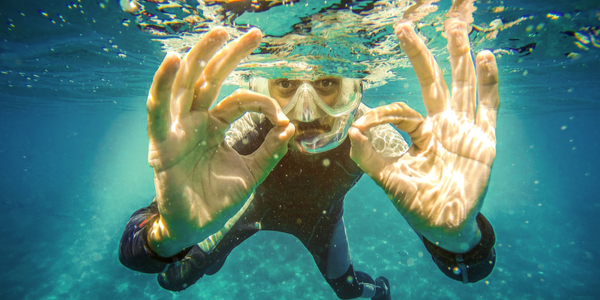
22 Sep WHAT ARE THE 10 BEST DIVE SITES IN TOBAGO?
The tropical paradise called Tobago is famous for its rich biodiversity and best dive sites. Lush foliage covers it from the highest point of 1800ft to sea level. The island also boasts of the best underwater view which is home to a wide variety of marine life forms. Wait till you take that plunge into the warm deep blue ocean that surrounds the island. The riotous hues of Tobago that greet you will shame any color palette you know of. It’s a completely different world out there. Between the hearsay and the actual view, you can only stare and gasp at the rich marine diversity which is unimaginable until you see it.
Tobago’s Idyllic Locatoin
Tobago’s impeccable location includes the outflow from the Orinoco River of Venezuela, the Atlantic on its windward side and the warm waters of the Caribbean Sea on the other side of the island. This confluence explains the rich, unparallel species diversity from macro species to pelagic giants; every kind of species thrives here. Tobago is fed year-round by the nutrient-rich Guyana Current. This flow sustains and attracts the exuberant number of life forms which is unparalleled to anywhere else in this hemisphere.
The huge abundance of stunning underwater diving sites is a sharp contrast to the island’s small size. Not to mention the unrivalled singular beauty of the diverse life will stun you like nothing else. Thankfully the dive facilities have way improved in recent years. So much so that they can proudly stand at par with any other Caribbean diving points. From the ace divers to the novice, even snorkelers,
Tobago underwater has enough to satisfy the taste buds of all levels of experience. With more than 50 established spots, an imposing number for such a small island, Tobago is the place to be for your next vacation to have the most unforgettable experience of your lifetime.
What Are The 10 Best Dive Sites In Tobago?
From beginner to world-class diver the 1o best dive sites of Tobago are worth every bubble. The 10 best locations are 1) Speyside, 2) Kelleston Drain, 3) Japanese Garden, 4) Bookends, 5) Mr. Irvine Wall, 6) M.V. Maverick, 7) Cove Crack, 8) The Flying Reef, 9) The Sisters and 10) Kariwak Reef.
Table of Contents
SPEYSIDE AREA

To experience Tobago’s famous drift diving, head over to the Speyside area on the island’s northeastern edge. Here the buffeting action of the Atlantic will thrust you effortlessly along the sloping reefs, rich in diverse forms that encompass the area’s offshore islands. Speyside is known for its wild and extravagantly beautiful reefs, It offers some of the best dive sites on the island. The visibility is superb for the most remarkable sightings which go on to attract the most experienced divers.
Of the 10 best dive sites, Speyside provides the Kelleston Drain, the London Bridge area and the Japanese Garden. Combined they provide the most spectacular reef exhibits you don’t want to miss. From the elusive Manta rays to spotting hawksbill turtles. Not to mention the nurse sharks, it’s home to some of the most astounding corals of the world.
KELLESTON DRAIN
.

Situated off Little Tobago towards the drift dive site, this place is famed to house the world’s largest brain coral. Kelleston Drain measures around a whopping 15 ft in diameter. At that size, you certainly will have to take out a few minutes to explore this humongous gem.
Along with morays, nurse sharks cruise around this area,. You may also have a close encounter with gorgonians, swaying sea fans, sea whips, small feather black coral and a huge collection of hard and soft corals along with multicolored sponges. The luckiest few might also come up close and personal with the majestic manta rays. So be on your guard and enjoy the phenomenal views.
JAPANESE GARDEN
.
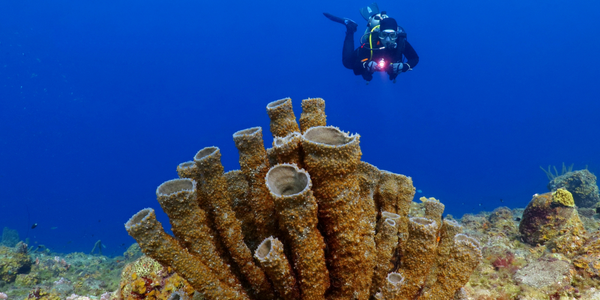
Located around the southern tip of Goat Island, this is a fascinating inclusion n the 10 best dive sites. The Japanese Garden has the most magnificent range of corals and is suitable for all levels of divers. Resembling a miniature Japanese Garden, this underwater haven is much more than its namesake.
When you swim along you will see among a plethora of varied fish species layers of brightly coloured sponges. This is complemented by hundreds of gorgonians in between, bright yellow, orange, red, olive tube sponges. Your wonder will continue with sea rods and barrel sponges in different hues. Eventually, you will finally reach the famous Kamikaze tunnel. This is lined by cup corals the other side of which is the famous serene Japanese Garden.
The Atlantic currents are quite strong around this area. It is therefore suggested to get inside the tunnel. There you can enjoy the scenic delights at a slower pace before reaching the ultimate showstopper. Before you do you will catch glimpses of sea whip corals that resemble bonsai plants. Also don’t miss the damselfish and angelfish which will dart past you.
Among the brightly-hued corals, colorful sea fans gently sway horizontally in the Atlantic drift. Banded coral shrimps play hide-and-seek among the gigantic barrel sponges; Collectively tthis site is like a riot of sparkling colors that guarantees to leave a lasting taste for visitors daring to take the plunge.
Travel advice:
Do carry a reef hook to secure yourself to a rock. Not corals or sponges to ensure their longevity. If you plan to take these dives. It is a perfect tool to slow down in the huge current while enjoying the beauty without destroying the reef.
BOOKENDS
.
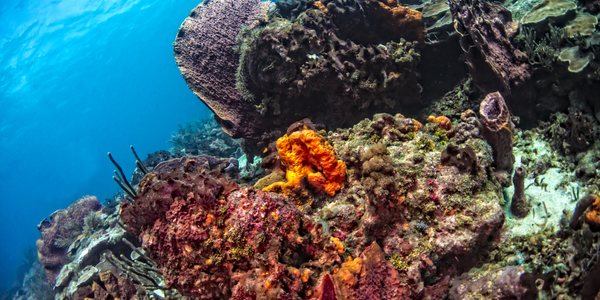
South of the main Speyside area, this spectacular diving spot is unique in its appearance. It is a twinned set of huge vertical slabs of rocks that stick out from the water to form a breathtaking structure that looks like a natural amphitheater. Descending can be a bit difficult. At times due to the turbulent water currents, this dive is recommended for intermediates and skilled divers. You will encounter voracious gigantic tarpons whizz past in the surf zone. They join mammoth-sized morays that swim past nonchalantly. Not to be left out microscopic-sized fishes teem all around amidst the richly hued elkhorn-corals, barrel sponges and sea whip. All this reflects the benefit that the nutrient-rich currents of Tobago have on its marine diversity.
MOUNT IRVINE WALL
.

The Caribbean coast of Tobago offers the best dive sites for novices as well as certified ones, as per their suitability. For a perfect introduction to marine diversity, this area provides some of the best relaxing dive points for first-timers. The not-to-be-missed renowned Mount Irvine Wall being one of them with its rocky outcrop that divides Mount Irvine and Stone Haven Bay.
The great “wall” is encased with innumerous corals. Its hallmarks are the crevices and ledges that are home to a plethora of sponges, crabs, moray eels, fireclams, sea horses, queen angelfish and other fascinating reef fishes. Following the outcropping rocks, is a larger coral reef area known as the Extension. This is the deeper diving part of Mount Irvine and it harbours larger species like the tarpons, hawksbill turtles and the spotted eagle ray which are common sightings here.
MV MAVERICK
.
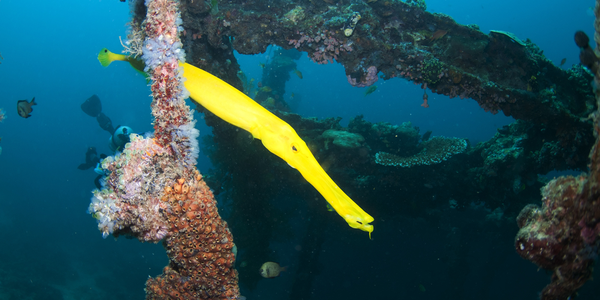
Once a passenger sailing between the twin islands of Trinidad and Tobago, the wreck of MV Maverick lies at a depth of 100ft is at present a dramatic dive site. In 1997, the tourism department recognizing the tourism and fishery benefit created an artificial reef by intentionally sinking this ship, then called the Scarlet Ibis, after weeks of effort. 34 years down the line, it has transformed into a flourishing ecosystem brimming to the core with marine life. It is now the residence of choice for darting bonito fish, swirling schools of rainbow runners, clams, lobsters and varied hues of corals and Sometimes you might catch the great Barracuda making a regal appearance or moray eels sneaking among the remnants.
COVE CRACK
.
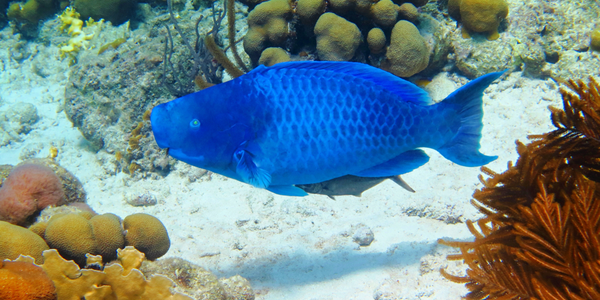
For the advanced level divers, Cove Crack is the ideal dive site because of its steep gradient and presence of pretty strong currents. Situated south of Columbus Point, it’s like a nursery for baby fish as well as the abode of larger pelagic species. Teeming over the sea fans and corals, you can easily catch sight of rays, Parrotfish, purple creole wrasse or a silver Bermuda chub wading by.
This diver’s paradise boasts of an impressive array of exquisite sea fans, sea rods, brain corals and fire corals along with groupers, parrotfish, moray eels, stingrays and sometimes the hawksbill turtle too. Not only do you get to explore the astounding underwater topography but also get the privilege to admire the diverse forms of marine life thriving among the crevices and ledges.
FLYING REEF
.
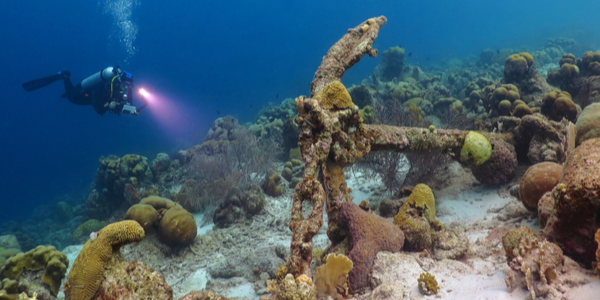
A short boat ride from the Crown Point/ Pigeon Point beaches will take you to this exquisite and popular dive spot. Especially recommended for beginners in drift diving, Flying Reefs offer the perfect start to all freshers willing to explore the underseas. The current is usually slow and gentle but it’s better to be alert round the clock as sometimes higher speed drift dive along the reef. From striking plate corals, parrotfish, porcupine fish to the rare cornetfish, bigeye to glasseye snapper, the fish variety and density will leave you spellbound. Be on the lookout for barracudas, blacktip sharks and stingrays too as they might surprise you once a while.
THE SISTERS
.
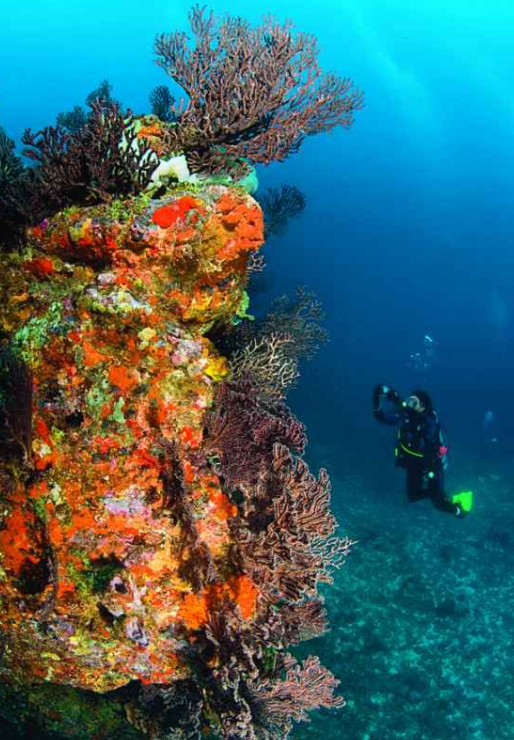
Centered around a unique collection of underwater rock formations, the islands of the Sisters are located further up towards the northern coast of Tobago. Situated 1.5miles away from the shore, It offers several excellent dive points extending to a depth of 140 ft thus providing excellent opportunities to seasoned divers to swim along with some larger pelagic species. During the winter months when the water is comparatively cooler, this becomes one of the best dive sites where large schools of hammerhead sharks assemble. Off Englishman’s Bay, the huge rock pinnacles rooted underwater on the ocean floor and the gigantic boulders provide the best habitat for turtles, lobsters, moray eels, manta rays and a variety of tropical fish.
KARIWAK REEF
.
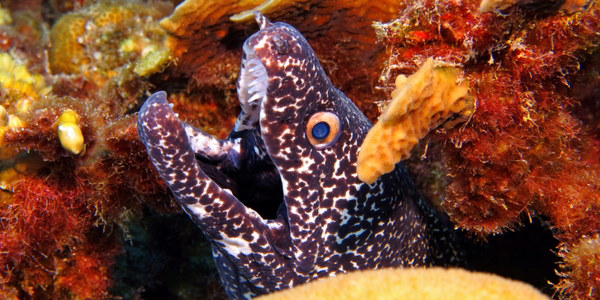
Situated 120 feet off Store Bay, Kariwak Reef is out of the ordinary as it is best suited for night diving because of its navigability. Easy accessible as a shore dive or from the boat, it is an excellent dive site for novice divers as well as children. The water being comparatively shallow and due to the near absence of underwater current, it is also a haven for underwater photographers who wish to capture the brilliantly hued marine life. Catch a glimpse of a moray eel, octopus, electric rays, scorpion fish, barracudas, parrotfish, angelfish, or southern stingray swimming past. If you are lucky, you might also see a flying gurnard walking around on its finger-like spines.
Travel advice:
- t is advisable not to walk on the reefs or touch the coral formations. Enjoy the beauty in the lap of nature without disturbing it.
- Be extra vigilant about the boat traffic.
- You must be a certified diver if you want to rent diving equipment. Additionally, you can also take instructional courses at local dive centres.
- You can opt for the PADI (Professional Association of Diving Instructors) courses.. This is the most coveted and sought after diving course worldwide which is internationally recognized. They will make the best course suited for you and your vacation plans. You can choose from beginners course of scuba diving to open water diving courses. Additionally you can access advanced courses to increase your confidence and skills
- Visibility might be hindered during the rainy seasons due to the run-off from the Orinoco River.
Final Words
Tobago has long been recognized as the Caribbean’s finest and popular diving destination. Because of its fringing reef system, many of the best snorkeling spots are accessible from shore. The wide display of marine life that you will encounter through diving and snorkeling will be worth the dive and at the end of the vacation, you will sit back and marvel at being the audience to nature’s greatest spectacles.
If you got time after you scuba to check out some of the key events in Tobago read our top Tobago Festivals picks.


Aly
Posted at 14:46h, 09 NovemberOoh, I have not yet been to Tobago, but the location is not too far away and the travel there would be much easier than a lot of other well-known diving destinations. I definitely like to see the most spectacular corals and brightly colored fish when on dives, so this list is very helpful to get an idea of what types of dives that Tobago has to offer. Thank you!
Melting Pot
Posted at 01:03h, 10 NovemberWell come on down Aly. You are missing out on the time of your life. The diving experience is really one you should put on your bucket list and enjoy. Look forward to seeing you in the future.
Daniel Tshiyole
Posted at 16:19h, 09 NovemberFirstly, I need to learn how to swim. But once I have learned how to swim, I am definitely visiting Tobago. What country is it in and will the plane ticket be too expensive? This is a nice place to go with my partner as I like to try adventurous things.
Melting Pot
Posted at 01:00h, 10 NovemberHi Daniel Tobago is an island and is part of the twin-island state called Trinidad and Tobago. Depending on the time of year you can get a ticket from Miami for about $400. So not too expensive. And when you get here the cost of living is relatively inexpensive. I am sure that you and your partner will have a fabulous time.
Dr. Baker
Posted at 22:35h, 09 NovemberThank you for this wonderful article! I got the pleasure of diving in Antigua for my first diving experience. My question is regarding the PADI course. I was wondering how long the course takes? Is it something that you can complete in a couple of hours or does it consist of multiple days of lessons? Thank you!
Melting Pot
Posted at 00:54h, 10 NovemberIt’s possible to complete your confined and open water dives in three or four days by completing the knowledge development portion via PADI e-learnig, or other home study options offered by your local dive shop or resort.
Some swimming ability is required. You need to have basic swim skills and be able to comfortably maintain yourself in the water. Your PADI Instructor will assess this by having you:
Swim 200 metres/yards (or 300 metres/yards in mask, fins and snorkel). There is no time limit for this, and you may use any swimming strokes you want.Float and tread water for 10 minutes, again using any methods you want.
All student divers complete a brief scuba medical questionnaire that asks about medical conditions that could be a problem while diving. If none of these apply, sign the form and you’re ready to start.